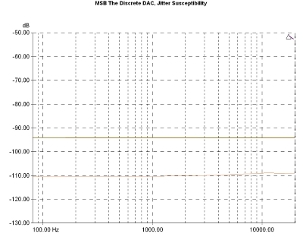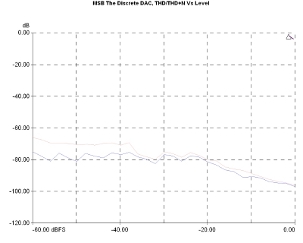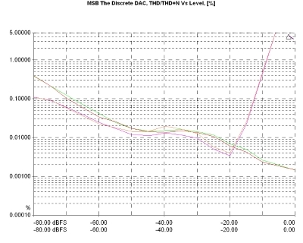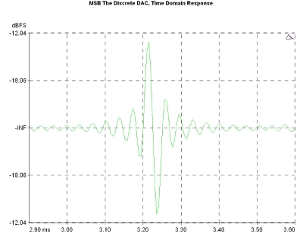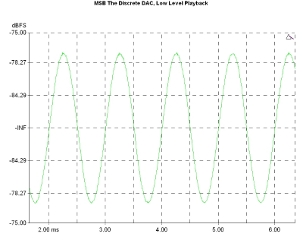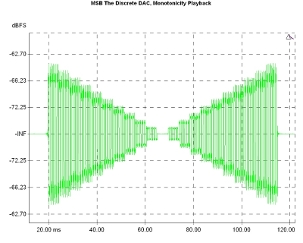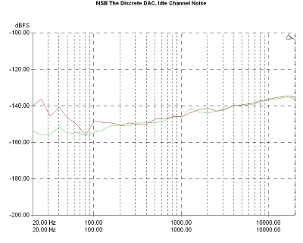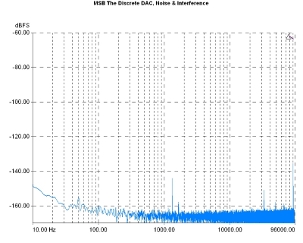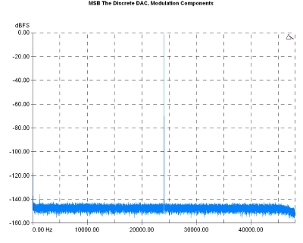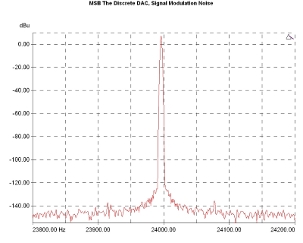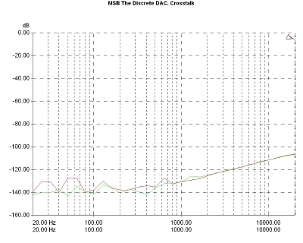about Audio, High Fidelity
& Home Entertainment technologies
pid: 607-2025/10/01 (v1.2)
Privacy Policy
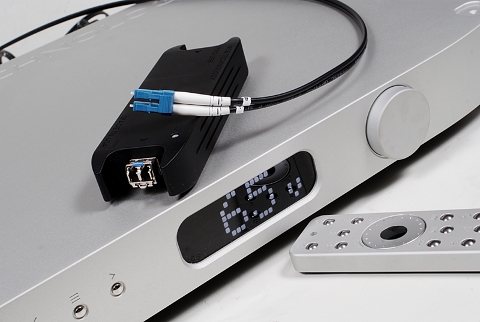
Unless otherwise mentioned, Discrete's evaluation was done through the coaxial digital input using 24-bit/96kHz signals. The device was, also, evaluated as a Network Renderer, through the Ethernet port, streaming files stored on the local NAS.
The digital interface proved to be the best we have measured to date, offering a suppression ratio of incoming jitter that is systematically around the -70dB point, with the higher values not exceeding -65dB, in the very low-frequency range.
As a result, the effect of the source jitter is very small. The corresponding graphs are just above -95dB, for low and medium frequency signals and around -110dB for high-frequency signals (24kHz), a performance that must be considered excellent.
In practice, (and with the available calculation method) Discrete introduces a minimum of jitter. We calculated a value around 44ps (p-p) and a very low frequency (5Hz). Above that, there is nothing worth mentioning.
Jitter attenuation vs jitter frequency. Signal 10kHz, injected jitter 80nS p-p.
Jitter susceptibility. 96kHz sample rate, -3dBFS signal with 40nS sinusoidal jitter injected, FS/192 (green curve), 997Hz (red), FS/4 (Orange).
Level linearity was also on the top level. The graphs maintain a perfect form down to -100dBFS but remain perfectly accepted down to -120dBFS. This is an impressive performance, which is also the best we have measured.
Such a performance is a predictor for very low distortion and, indeed, this was what we got: at high signal levels, the graphs were around -95dB, an expected result, but at low signal levels the results were much better than we anticipated. For a -60dBFS signal the harmonic distortion was below -75dB, with the total distortion and noise below -65dB, an impressive performance, to say the least.
Output level linearity. Signal frequency 1kHz, sample rate 96kHz.
Harmonic Distortion Vs Level, 24-bit/96kHz. THD+N (pink curve), THD (purple).
Of course, there is always something to criticize… The attenuator plays an important role in the behavior of the device. The relevant diagram (here in percentage figures) shows that the "100" setting allows the output to fall comfortably down to 0.0015% for signals near 0dBFS, but the "106" setting drives the analog stage to overload, starting from -20dBFS and, typically, to clipping, close to -10dBFS. This result is difficult to comment on as the MSB does not explain exactly how the attenuator is calibrated (and what +6 means on the 100 scale). In any case, all the measurements were made with the attenuator at the “100” setting.
Relative to the signal frequency, distortion shows no signs of serious variation. The graphs are located below -95dB and a strange, at the first reading, sharp decline in the high-frequency region relates to the way the converter filters work.
Harmonic Distortion Vs Level, 24-bit/96kHz. THD+N, attenuator in the "100" position (red and green curve), attenuator in the "106" position (orange, violet).
Harmonic Distortion Vs Frequency, 24-bit/96kHz. Level: -1dBFS. THD+N (pink curve), THD (purple).
Discrete's filter response is quite interesting. Despite the impressive performance of the converter itself MSB has chosen a very strict filter strategy. First, it does not offer alternative filter responses and, second, the cutting-off frequency is below 30kHz for both 96kHz and 176.4kHz sample rates (maximum theoretical values here, would be 48kHz and 88.2kHz respectively). Two good reasons for this are shown in the corresponding graphs. To begin with, the slopes are relatively mild and, in addition to this, the stop band is extremely clean, perhaps the best we have seen, even in apodizing filters. MSB, however, does not mention a name for the filter in use.
The effectiveness of the filters in terms of noise components that are folding in the audio spectrum cannot be disputed, for sure. Although the curves are not flat, indicating an increasing noise level relative to frequency, they remain at very low levels, below -100dBFS up to 1kHz and below -90dBFS up to the measurement limit. (10kHz).
Low pass filter response, Linear Phase/Fast. 44.1kHz (orange curve), 96kHz (violet), 192kHz (blue).
Suppression of imaging components (96kHz sample rate).
On the other hand, the typically high slope filter used for the 44.1kHz sample rate introduces the standard, quite high pre- and post-ringing it the time domain response.
While in the time domain, it is worth seeing Discrete's behavior as a renderer, during streaming files from the network. Very low-level signal reproduction touched the perfection (which is not, however, unusual in devices of this kind) with the sine wave having minimal high-frequency noise, zero visible distortion, and, almost, absolute symmetry as to the axis of 0 (INF, in this case, as the calibration is in dBFS).
Time-domain response, 16-bit/44.1khz signal.
Low level playback (-80dBFS, 16-bit/44.1kHz, NAS/Ethernet).
Further, the reproduction of the monotonicity test signal is also excellent. Here, one can discern that different levels appear clearly defined, without noise and with minimal overshoot, while the minimum level and zero signals are extremely clear. You will never see these things in optical/mechanical transports.
Judging by its construction, Discrete was expected to have some serious noise performance. It did not negatively surprise us, as the spectrum on the idle channel noise was, at low mid frequencies, below -140dBFS and did not exceed -110dBFS at the measurement limit. Static noise measurements were equally great: -126dB-CCIR signal to noise ratio, 128dB dynamic range, and 0.3uVrms of power line-related noise, are figures not easy to beat and, most importantly, objectively justify MSB's design decisions at every level.
With such noise performance, the relevant spectra are, more so, a way of visual confirmation and, less, something to study. The noise spectrum has 50Hz components (below -150dBFS), with other findings within the acoustic spectrum not exceeding -145dBFS, while residuals in the very high-frequency band are below -130dBFS.
This significantly reduces the chances of modulating the signal by noise, which is made clear from the completely “blank” signal modulation spectrum, where all you can see is the 24kHz fundamental.
Going up in resolution to look at the effect of very low-frequency noises, the image does not change drastically. The levels remain at extremely low values and all you can see is an indefinable modulation very close to the tone (probably due to the jitter we calculated). In any case, we are talking about level findings below -120dBu (this corresponds to a level of 0.000002V p-p).
As the last proof of Discrete's quality, it is worth looking at the channel crosstalk behavior. This is, at worst, close to -110dB, with the device going below -120dB at 4kHz. This is another point where we are talking about the best performance we have seen to date.
Previous | Next | More Reviews


